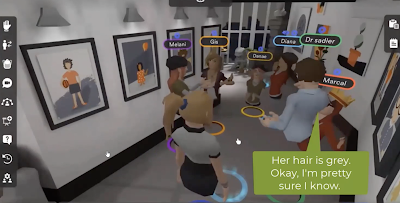Part of the EU Center’s fall 2022 Transatlantic Educators Lecture Series, Thrasher’s presentation provided an overview of different types of VR devices, recommendations for language learning VR apps, and tips on integrating VR into the classroom and acquiring headsets. Prior to working at Immerse, Thrasher taught French at UIUC for five years, and she drew on her own experience using VR with her students for her presentation.
First, why use VR in the language classroom at all? Aside from the ability to transport students to culturally relevant locations and immerse them in the target language, VR boasts the research-backed benefits of lower student anxiety, higher motivation and engagement, and opportunities for more student-centered collaborative interactions. This can be particularly valuable for language classes, where progress depends so much on students’ willingness to speak up in class.
VR devices range from simple and affordable viewing devices such as Google Cardboard and Google Daydream to standalone headsets like Meta Quest 2 and HTC Vive Focus 3 to the most expensive models like Valve Index and HTC Vive, which are tethered to a computer. Headsets can be prohibitively expensive (the Meta Quest 2, one of the more affordable headsets, typically retails for $399). However, many VR applications do not require a headset and can be used with a personal computer, tablet, and smartphone.
Apps designed specifically for language learning can be categorized into human-to-computer interaction and human-to-human interaction. The former allows for asynchronous learning, whereas the latter would require teachers to be in VR along with their students. Mondly and ImmerseMe are two applications that use human-to-computer interaction, which, Thrasher says, is better “for lower-level students who are still practicing interactions like ordering a coffee or buying something at the store.” Students would put on a headset (or turn on their devices), log into the application, and interact with chatbots.
In contrast, in an application using human-to-human interaction like Immerse (Thrasher’s employer), teachers interact with their students in VR. Immerse is currently the only VR app on the market that is designed for synchronous language teaching. In the screenshot below, Thrasher and Randall Sadler, an associate professor of linguistics at UIUC, use Immerse to teach English learners from Spain, who are describing the portraits on the wall.
Then there are general social VR platforms like Alcove, vTimeXR, and Spatial, which are not specifically designed for education but can be used for educational purposes, such as bringing students together into a VR space for collaboration and discussion. Spatial allows users to build their own VR spaces, and there is the option of creating a password-protected space just for your students. One of Thrasher’s current projects involves bringing together UIUC students learning Japanese and Japanese students learning English and having them build an art gallery in Spatial that showcases what they’ve learned about each other’s culture. Thrasher also recommends looking into Mozilla Hubs and Alcove. Mozilla Hubs, which is free to use and does not require a VR headset, lets users design private meeting spaces using the app’s library of 3D objects and share external content such as Kahoot games and YouTube videos.
Video tours and multiplayer and single-player games can also be valuable tools in language classrooms. Wander, which Thrasher describes as “Google Earth meets VR,” allows students to explore parts of the world where the target language is spoken. An activity Thrasher has used with her students is to have them go into the same place in Wander and describe to each other, using the target language, what they are seeing. Students can also act as tour guides and present on a place in Wander to their classmates.
Thrasher concluded her presentation with tips on starting to use VR in your classroom. “I really cannot emphasize enough the importance of training,” Thrasher said, “This goes for both training yourself and your students to use the headsets.” VR is not necessarily intuitive even for digital natives. Hence, Thrasher recommends practicing presenting a lesson to a friend using any given VR app before using it in the classroom.
A remote learning format can be perfect for VR if headsets are not required: students would all log into the VR app from their personal computers like they log into Zoom. If students are using VR in a physical classroom, Thrasher recommends giving yourself enough time for equipment and classroom setup. Make sure that your headsets are charged and that your apps are downloaded and updated, so that your students can come in, put on their headsets, and immediately get to work.












